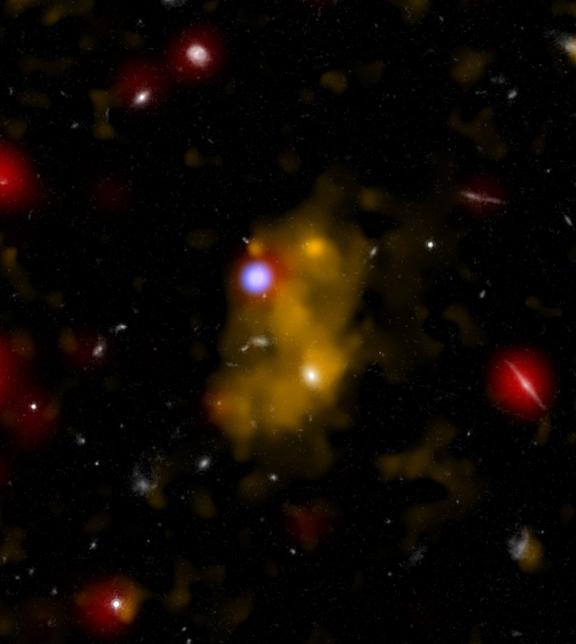
An multiwavength image of a Lyman alpha galaxy. Astronomers have studied 3700 such galaxies in the early universe to determine how much of the hydrogen emission is produced by star formation and how much by an accreting black hole. In this image yellow is the hydrogen gas glowing in Lyman-alpha; white shows the main galaxy; red is infrared as seen with the IRAC camera; and blue is X-ray emission showing evidence for a supermassive black hole.
Massive galaxies in the local universe, in order to be large today, probably began forming their stars in the early universe. Astronomers do indeed see significantly enhanced star-formation activity in distant galaxies and find that the peak star formation rate occurred when the universe was only about two billion years old. Galaxies actively making stars naturally produce many that are massive and hot. They emit ultraviolet radiation that ionizes hydrogen gas which in turn radiates in characteristic spectral lines; the most energetic of these hydrogen features, the Lyman alpha line, itself lies in the ultraviolet. Since galaxies are expanding away from us, however, their apparent spectrum is shifted to the red and their Lyman alpha line is shifted to visible wavelengths or longer, where optical instruments can detect it.
Lyman alpha emitters ("LAEs") are galaxies or clusters of galaxies that are bright in this hydrogen feature, and astronomers piecing together the star formation history of the universe use LAEs to trace the cosmic evolution of matter. There is one major complicating factor however: supermassive black holes at galaxy centers accrete matter (AGN: active galactic nuclei) and also produce copious amounts of ultraviolet radiation and hence Lyman alpha light. An accurate accounting of star formation using ultraviolet light has to account for the effects of black hole accretion.
CfA astronomer Andra Stroe was a member of a team that examined the X-ray and radio activity of about 3700 LAEs to search for and quantify their AGN contributions to the radiation using the distinctive character of accretion radiation at these wavelengths. Their set of objects dates from the epochs between one and two billion years after the big bang, and was selected from deep optical and near infrared images, Chandra X-ray observations, and radio data from a Very Large Array survey. They found that 6.8% of the LAEs were also detected in X-rays and hence could be classified as AGN, and that the luminosity of the X-rays correlated with the Lyman alpha strength in these objects suggesting that the hydrogen emission was AGN produced. Summing together the X-ray images of all the other LAEs objects still did not reveal any X-ray emission, implying at most a very low accretion rate in these objects. An even smaller percentage of LAEs, only 3.1% , showed radio emission and there was no correlation between the radio and Lyman alpha fluxes, although this might be due in part to detection limits. Overall, the scientists conclude that LAEs at cosmological distances are mostly star forming (with relatively modest rates, on average about seven solar-masses per year of new stars) and with relatively low AGN accretion except for small subset of X-ray bright objects. The results are a large statistical smaple that support and refine the standard model of galaxy evolution and the character of LAE galaxies in the early universe.
"The X-ray and Radio Activity of Typical and Luminous Ly α Emitters from z ∼ 2 to z ∼ 6: Evidence for a Diverse, Evolving Population," João Calhau, David Sobral, Sérgio Santos, Jorryt Matthee, Ana Paulino-Afonso, Andra Stroe, Brooke Simmons, Cassandra Barlow-Hall and Benjamin Adams, MNRAS 493, 3341, 2020.